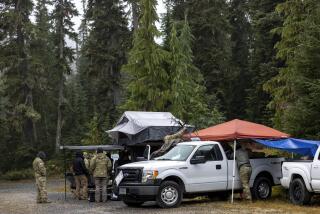Fake Disaster Puts Rescuers to a Real Test
Make-believe victims of a staged plane crash lined the airfield at Point Mugu’s Naval Air Station, waiting on stretchers to be taken in ambulances to local hospitals.
Their faces were covered with makeup resembling cuts, burns and bruises, and their bodies were wrapped in bandages and blankets.
Practicing for a real-life disaster, emergency crews from throughout Ventura County and nearby counties descended upon the Navy base Tuesday for a simulated midair collision that supposedly killed four people and injured 48 others. Everyone from the Coast Guard to the Red Cross participated in the emergency drill, designed to prepare the county for a major disaster.
“This is a special opportunity, because we get to test things out before anything actually happens,” said Sandi Wells, Ventura County Fire Department chief information officer. “We get to look at all the what-ifs and see how we would react.”
The exercise, which involved about 140 people, was the first emergency drill of its size in eight years. Participants included the Navy, the Ventura County Sheriff’s Department, the American Red Cross, Aspen Helicopters, Mercy Air, fire departments from throughout the county and emergency medical services from Los Angeles, Ventura, Santa Barbara and Orange counties.
The pretend passengers were all volunteers, many from local colleges or city disaster-preparedness teams.
“The whole purpose here is to have an overwhelming situation so we can pool our resources and provide patient treatment and transportation to local facilities,” said Oscar Soto, an assistant chief for the Fire Department that serves the Navy base. Soto headed up the drill.
The imaginary collision occurred between a 30-passenger commuter plane out of Oxnard and a 50-passenger government charter plane on its way to San Nicolas Island. One of the planes plunged into the ocean, while the other crashed on land nearby. Twenty-five Navy divers, playing victims, landed in the water off the base’s “family beach” and were immediately lifted out of the water by Coast Guard and Navy personnel.
A Coast Guard helicopter flew the divers to the airfield and swapped them with community volunteers. Then fire and medical officials separated the make-believe victims into four categories: immediate, delay, walking wounded and deceased. The immediate victims were the ones with life-threatening injuries, the delay passengers had burns and fractures and the walking wounded had smaller cuts and bruises.
Chief Parke Bradley of the Naval Air Reserve asked the “walking wounded” victims for their names and checked on their injuries. When he came to Judi Daufeldt, he reassured her that “we’re gonna put you on the bus here real soon.”
But she was eager to play her part.
“I can’t walk,” she said, pointing to the bandages around her knees. “I have burns on my legs and it hurts too much to walk.”
While the victims were being transported to St. John’s Regional Medical Center and other local hospitals, Red Cross volunteers counseled family members in the Navy chapel.
Soto said this month’s Amtrak train derailment in Illinois made the emergency exercise even more critical. But he said he thinks the county is ready if a real-life disaster does occur.
“If we had an Amtrak incident like that, there is no doubt in my mind that with the combined efforts of Ventura County and the other counties, there’s not much of anything that we can’t overcome,” Soto said.
More to Read
Sign up for Essential California
The most important California stories and recommendations in your inbox every morning.
You may occasionally receive promotional content from the Los Angeles Times.










